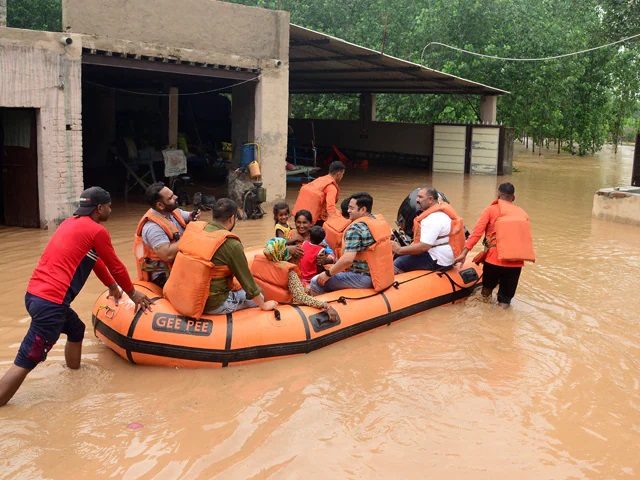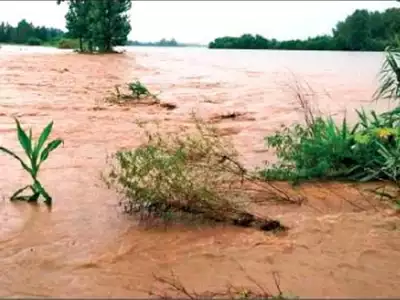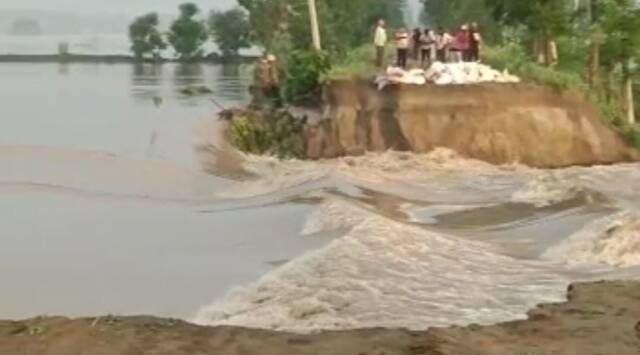Floods in Punjab 2023
Floods in Punjab 2023 have caused widespread devastation across the state, leaving a trail of destruction in their wake. As the floodwaters surged, numerous areas and districts in Punjab bore the brunt of this natural calamity. we take a closer look at the affected regions and districts, highlighting the extent of the damage and the challenges faced by the local communities.
Amritsar District: Amritsar, a historically and culturally significant district, faced the wrath of the floods. Several low-lying areas and villages, including Tarn Taran, Ajnala, and Chogawan, witnessed heavy inundation. The floods wreaked havoc on agriculture, damaging crops, affecting livestock, and causing significant economic losses.
Jalandhar District: Jalandhar, a bustling urban center, experienced severe flooding in many of its localities. The areas adjacent to the Sutlej River, such as Nakodar and Shahkot, encountered extensive waterlogging, leading to the displacement of residents and disruption of essential services. The floodwaters submerged roads, residential areas, and vital infrastructure, posing significant challenges for the district’s authorities.
Ludhiana District: Ludhiana, Punjab’s industrial hub, witnessed widespread flooding, affecting both urban and rural areas. Localities such as Machhiwara, Sidhwan Bet, and Sahnewal faced inundation, resulting in the displacement of residents and damage to homes, businesses, and agricultural lands. The floods severely impacted transportation, hindering the movement of goods and people.
Ferozepur District: Located along the border with Pakistan, Ferozepur district experienced the devastating impact of the floods. The overflowing Sutlej River caused extensive damage to villages and agricultural lands, disrupting the lives and livelihoods of thousands of residents. Rehabilitation efforts have been challenging due to the extensive damage to roads, bridges, and communication networks.
Patiala District: Patiala, the administrative capital of Punjab, witnessed significant flooding in its low-lying areas, including Samana and Rajpura. The floods resulted in the evacuation of residents and posed severe threats to public health and sanitation. Agriculture, a crucial economic sector in the district, suffered substantial losses, exacerbating the economic impact of the floods.
Our teams are distributing cooked meals and safe drinking water to the flood affected victims in Morinda, Punjab.
— Khalsa Aid India (@khalsaaid_india) July 10, 2023
We are thankful for the support of the sangat.🙏🏽 #khalsaaidindia #sewa #floods #punjab pic.twitter.com/2lIxy8Gr7p
The recent floods in Punjab have left no corner untouched, and the districts of Fatehgarh Sahib, Sirhind, and Morinda have experienced the brunt of this natural calamity. These regions, known for their historical significance and vibrant communities, have been severely affected by the flooding.
Fatehgarh Sahib: Fatehgarh Sahib, an important district with historical and religious significance, has witnessed extensive damage due to the floods. The overflowing Sirhind Canal and excessive rainfall have led to waterlogging in several parts of the district. Villages like Bassi Pathana, Khamanon, and Amloh have been severely affected, resulting in the displacement of residents and damage to homes and agricultural lands.
Sirhind: Sirhind, an ancient town situated in Fatehgarh Sahib district, has a rich historical background. However, it has been significantly impacted by the floods. The overflowing Ghaggar River and its tributaries have caused widespread inundation in low-lying areas. As a result, residential areas, markets, and public infrastructure have been submerged, leading to the displacement of residents and disruption of daily life.
Morinda: Morinda, a town located in Rupnagar district, has also faced the wrath of the floods. The overflowing Sutlej River and heavy rainfall have caused severe waterlogging and submergence of low-lying areas. The floods have resulted in damage to residential buildings, agricultural fields, and essential services. The transportation network has been severely affected, hampering the movement of people and goods.
The recent floods in Punjab have left a lasting impact on Ropar, a district located along the banks of the Sutlej River. The overflowing river, coupled with incessant rainfall, has caused widespread devastation in this area. In this article, we delve into the impact of the floods on Ropar and the surrounding Sutlej River area, highlighting the extent of the damage incurred and the ongoing recovery efforts.
Severe Flooding and Water Inundation: The floods have resulted in unprecedented water levels in the Sutlej River, leading to severe flooding in Ropar. Low-lying areas, including towns and villages situated along the riverbanks, such as Ropar, Kurali, and Chamkaur Sahib, have experienced extensive inundation. The rising waters have submerged residential areas, agricultural fields, and public infrastructure, causing significant damage.
Displacement of Residents: The floods have resulted in the displacement of residents in Ropar and the surrounding areas. Many families have been forced to leave their homes and seek refuge in relief camps and temporary shelters. The displacement has posed challenges in terms of providing immediate relief, shelter, and essential supplies to the affected population.
Damage to Infrastructure: The floods have caused severe damage to infrastructure in Ropar and its vicinity. Roads, bridges, and other transportation networks have been washed away or rendered impassable, disrupting connectivity and hindering relief efforts. The inundation of public buildings, schools, and healthcare facilities has further compounded the challenges faced by the local authorities.
Impact on Agriculture: Agriculture, a significant economic sector in Ropar, has been severely impacted by the floods. The fertile agricultural lands along the Sutlej River have been submerged, resulting in the destruction of crops and loss of livelihood for farmers. The long-term consequences of the floods on agricultural productivity and the local economy are expected to be significant.
Flood Havoc in Mohali, Chandigarh, and Panchkula
The recent floods in Punjab have also taken a toll on the adjoining regions of Mohali, Chandigarh, and Panchkula. These urban areas, known for their infrastructure,commerce, and residential developments, have faced significant challenges due to the torrential rainfall and subsequent flooding.
Mohali: Mohali, a rapidly growing city neighboring Chandigarh, experienced substantial flooding during the recent calamity. The overflowing Ghaggar River and the extensive waterlogging severely affected many areas, including Sohana, Kharar, and Zirakpur. The floods led to the submersion of residential complexes, damage to public infrastructure, and disruption of essential services. The economic consequences were significant, with businesses and industries suffering losses, while agriculture faced substantial damage.
Chandigarh: Chandigarh, the capital city of both Punjab and Haryana, witnessed its share of devastation due to the floods. The low-lying areas of the city, including sectors near the Sukhna Lake, were particularly affected. The overflowing water bodies, combined with heavy rainfall, resulted in the inundation of residential colonies, commercial spaces, and vital transportation networks. Several sectors, such as Sector 17, Sector 22, and Manimajra, faced severe waterlogging, causing immense hardship for the residents.
Panchkula: Panchkula, a satellite city located in Haryana adjacent to Chandigarh, also suffered from the impact of the floods. The overflowing Ghaggar River and heavy rainfall led to flooding in areas like Pinjore, Kalka, and Sector 20. Residential areas, farmlands, and industrial zones were submerged, causing significant damage to properties and infrastructure. The displacement of residents and disruption of basic amenities posed considerable challenges for the local authorities.
Consequences of the Floods:
The floods have brought forth a range of devastating consequences, including:-
- Displacement and Humanitarian Crisis:Thousands of people have been displaced from their homes, seeking refuge in relief camps. The floods have created a humanitarian crisis, with basic amenities and livelihoods severely impacted.
- Agricultural Damage: Punjab’s agricultural backbone has been hit hard by the floods. Crops have been destroyed, livestock has been lost, and agricultural infrastructure has been severely damaged, posing long-term economic challenges.
- Infrastructure Destruction: The floods have caused extensive damage to roads, bridges, public buildings, and communication networks. Transportation and connectivity have been disrupted, hindering relief efforts and recovery.
Relief and Rehabilitation Efforts:
- In response to the floods, a coordinated effort involving government agencies, relief organizations, and volunteers is underway. The focus of these efforts includes:
- Rehabilitation and Reconstruction: Supporting the rebuilding of homes, agriculture, and infrastructure to restore normalcy in the affected areas.
- Long-term Resilience: Implementing measures to mitigate future flood risks, including enhancing drainage systems, strengthening embankments, and improving early warning systems.









